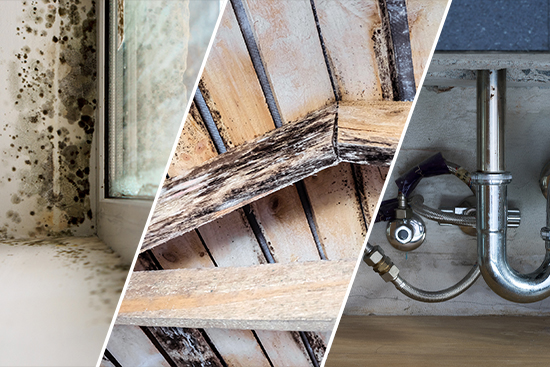
So, it’s time to say hello to spring cleaning! Yes… again.
And while you get ready to once more pull out the disinfectant wipes, re-organize your drawers, and clean out the fridge, we’re going to cut to the chase:
Don’t forget to search for hidden mold while you’re tackling the house from floor to ceiling! Specifically, here’s where you may need to look:
#1 – Under the Sink
The area beneath your sink — both in your kitchen and your bathroom — is likely to be dark, poorly ventilated, and constantly exposed to moisture by virtue of the pipes and plumbing that run through it.
Thus, in order to prevent the growth of hidden mold, the Federal Emergency Management Agency (FEMA) recommends that property owners “fix leaks in pipes, and any damp areas around tubs and sinks, so that biological pollutants don’t have growing environments.”
#2 – In Your Chimney
As many homeowners today do not consider how their chimney may be the culprit of their indoor allergy woes, you might be surprised to learn that your chimney actually provides an ideal environment for mold growth.
Consistently dark, it is especially liable to grow mold if it has poor ventilation, features inadequate waterproofing materials, or experiences a chimney cap leak.
#3 – Behind Your Wall(paper)
“Building materials such as components made from wood chips or walls consisting of paper covered gypsum board are more sensitive to moisture than is plaster,” as explained by the American Society of Microbiology (AMS).
So don’t forget to look behind the furniture (and even behind the wallpaper itself) for mysterious blotches that merit more attention.
#4 – Home Furniture and Decor
According to the Centers for Disease Control, mold is capable of growing on both fabric and upholstery materials when provided the correct environment.
Thus, should an area in your house become subject to moisture intrusion and/or extensive flooding, your furniture and other vulnerable decor (like curtains, tapestries, rugs, and more), should be inspected for mold if not removed immediately.
#5 – Around Windows
Not only will warm and cool air collide along the frames and faces of your windows, thereby creating condensation, but a crack in the structure of your window is apt to allow outdoor moisture inside.
Otherwise, air cracks around your windows may also allow outdoor mold spores themselves to weasel their way inward, making it important to inspect your windows and then seal existing leaks or cracks with caulk.
#6 – In Your Carpet
Soft, fibrous, and capable of retaining both warmth and moisture, your carpet may be fostering mold spores unbeknownst to you. Particularly if you frequently spill food and/or beverages on the material, mold growth will proliferate.
In fact, in previous studies, results found that “removing the carpets [from within a property] significantly reduced the levels of both mite allergens and ergosterol, a component of the cell wall of molds.”
#7 – In Your Washing Machine
As handy as a front-loading washing machine may be, they may also unwittingly collect swaths of mold spores every time you toss in a load for another spin cycle.
This is because the folds in the airtight rubber seal at the front of the machine will collect water droplets, thereby retaining moisture even after a load is complete. Especially if you use the wrong detergent or fail to wipe it clean between cycles, mold is likely collecting and growing along the edges of the gasket.
#8 – In Your Attic
If your roof becomes unstable as a result of age or is subjected to storm damage, your attic will be particularly prone to collecting moisture and mildew.
But while you may not be able to control the weather, you can still keep the humidity levels in your crawl spaces and attic below 50 percent in order to prevent condensation and mold, as recommended by the Environmental Protection Agency (EPA).
#9 – In Your Grout
Grout in your bathroom tiles are assaulted time and again by the high volumes of moisture associated with your shower, toilet, and sink, making ventilation important if you’re going to prevent mold growth in your grout.
Your kitchen, on the other hand, may have more porous grout in the flooring tiles that are apt to catch and trap old food particles, thereby promoting the growth of mold, bacteria, and other undesirable contaminants.
#10 – Around Your Indoor Plants
While we all love the beauty our indoor house plants may bring to a room, they also have the potential to expose you to mold spores if not adequately cared for throughout the year.
For example, the Florida Department of Health (FLDOH) specifies that house plants may be a potential source of mold if they retain too much moisture in their soil, such as when they are overwatered.
That all said, mold can be a tricky villain to catch if you’re not sure what to look for, no matter how comprehensive your spring cleaning regimen is.
Thankfully, if you need help identifying potential pollutants and hazards in your property, Luce Air Quality has you covered… no matter the season!
Not only do we offer thorough mold inspections for both residential and commercial properties alike, but we also provide a bevy of other indoor air quality and environmental services, such as water damage investigations, healthy building check-ups, and more.
To learn more about how we can help you optimize your indoor air quality — or if you’re ready to schedule your mold investigation — contact our team today by calling (904) 803-1014 or emailing info@luceairquality.com!


